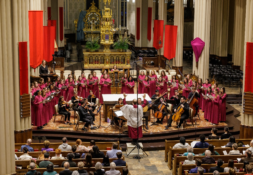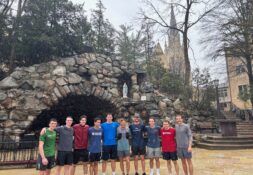A resident of Florence, Italy for the last ten years, sculptor Dony MacManus visited Notre Dame to talk about sacred art. His lecture Monday afternoon was an exhilarating and ennobling commentary linking scholars, artists, and the future of sacred art.
In his introduction, Professor Duncan Stroik contextualized the role of the talk within MacManus’ whirlwind tour of Catholic universities throughout the United States. These presentations are part of the groundwork MacManus is laying for a new English-language school of sacred art in Italy. The goal of his new program is no less than a total synthesis between the spiritual life of Western thought and the technical proficiency of figural art.
The connection, for the School of Architecture, is immediate and substantial. As MacManus observed, “Architects and artists need each other.” What we seek to do in embracing architectural classicism requires the contribution of all the arts for its execution. Beyond this, Notre Dame holds a unique position, not only for its stance on classical architecture, but for its Catholic intellectual tradition. Were Cornell or Yale to start running neo-classical programs tomorrow, they still could not achieve what Notre Dame naturally integrates.
MacManus sounded a similar note when asked to contrast his vision for sacred art with the prevailing state of art education. Distinguishing between two opposing camps, he faulted not only the secular art schools that retreat into abstraction and “empowering” self-expression, but also recent classically-based programs which focus on technical repertoire without probing the deeper human significance: “They were taught the language, but they weren’t taught to penetrate the language to arrive at the underlying thought.”
For MacManus, this thought begins with the human figure, which is the “fundamental” vehicle of communication: “The human figure is the ultimate expression of presence, and when confronted with that presence in art, we must acknowledge it.” He praised Pope John Paul II’s THEOLOGY OF THE BODY as instrumental in his pupils’ search for artistic meaning, saying it “was giving them an idea of what the body means to go along with the language.” Taking this notion further still, MacManus asserted that “the sacred, that is, the Church, is the only institution that needs art,” because the power and meaning of the human figure is found in the Incarnation.
“I don’t see a sincere cultural renewal without a revival of fundamentals, of the truth of the human condition,” MacManus continued. The enduring power of the human figure is undeniable. Indeed, our beings, the image and likeness of God, are the last, unassailable bulwark of meaning. Though we are bombarded by a popular culture that cheapens and exploits our image in every waking moment, our intrinsic humanity can never be trafficked out of existence. More often today, the reaction of our disordered society when “confronted with that presence” is to recoil in horror. On the reluctance of public committees to commission figural art, MacManus said, “a lot… are afraid of figural works because they actually mean something. There is a real fear of meaning in contemporary commissioning.”
Speaking of one of his own projects, a portrayal of St. Josemaria Escriva for the chapel of Opus Dei in Manhattan, he explained the thought behind his work: “Respect the liturgical hierarchy of the space; first, the tabernacle, the real presence; second, the altarpiece; third, the devotional image [Escriva].” The installation was to be life-sized, but a full-length statue would have dominated the space. Instead, MacManus created a bas-relief bust, with a full relief head, set into the wall and gesturing towards the tabernacle, a solution “reinforcing the orientation of the space.” Here MacManus intimates a profound concept: the real presence of Christ in the Eucharist is not only the source and summit of our faith, but also the foundation of representational sacred art.
Thus the technical language of figural art is but a means to an end. MacManus credited it with giving him the ability to discover “how the Incarnation is communicated through the great masters.” In describing the necessity of the truth of Christian iconography to the intrinsic meaning and value of art, he contrasted “penetrating the humanity of the great masters to communicate with people today versus learning to paint in the style of Michelangelo.” One is a technical feat, the other is true art. Rather than set up a false dichotomy between creating art “for our time” and the historic, figural tradition, MacManus had this advice: “You don’t have to try to be contemporary; we are contemporary. Develop the spiritual life and the artistic language. Steep yourself in the faith and tradition, and what results will be natural.”
Matthew Balkey is a fourth-year architecture student. He facetiously defines art as “anything with a column in it.” This newspaper counts. He can be reached at mbalkey@nd.ed





